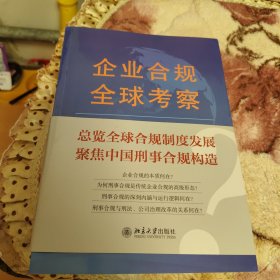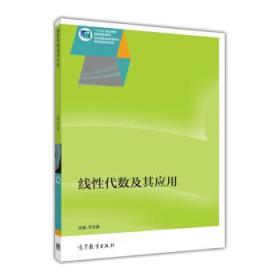
线性代数及其应用(第五版)(英文版)
¥ 15 1.5折 ¥ 99 九品
库存2件
山东济南
认证卖家担保交易快速发货售后保障
作者David C. Lay;[美]David C. Lay;Steven R. Lay;Judi J. McDonald
出版社电子工业出版社
出版时间2020-09
版次5
装帧其他
货号1226
上书时间2024-09-16
- 在售商品 暂无
- 平均发货时间 19小时
- 好评率 暂无
- 最新上架
商品详情
- 品相描述:九品
图书标准信息
- 作者 David C. Lay;[美]David C. Lay;Steven R. Lay;Judi J. McDonald
- 出版社 电子工业出版社
- 出版时间 2020-09
- 版次 5
- ISBN 9787121396175
- 定价 99.00元
- 装帧 其他
- 开本 16开
- 纸张 胶版纸
- 页数 568页
- 字数 1181千字
- 【内容简介】
- 线性代数是处理矩阵和向量空间的数学分支科学,在现代数学的各个领域都有应用。本书内容主要包括线性代数中的线性方程、矩阵代数、行列式、向量空间、特征值与特征向量、正交性与*小二乘、对称矩阵与二次型、向量空间解析几何等,目的是让学生掌握线性代数的基本概念、理论和证明。全书内容简洁、例题丰富、版式美观,除介绍基本概念外,还介绍了它们在各个领域中的具体应用。本书是一本介绍性的线性代数教材,内容翔实,层次清晰,适合作为高等学校理工科数学课程的双语教学用书,也可作为公司职员及工程学研究人员的参考书。
- 【作者简介】
- David C. Lay:美国伊利诺伊州奥罗拉学院学士,美国加州大学洛杉矶分校硕士和博士;自1966年起,他就主要在美国马里兰大学帕克分校从事数学教研工作;作为客座教授,他曾供职于阿姆斯特丹大学、阿姆斯特丹自由大学、德国凯泽斯劳滕大学;在泛函分析与线性代数领域发表论文30多篇。作为NSF发起的线性代数课程研究组的创始会员,David C. Lay是线性代数课程现代化新动向的领导者,也是几本数学教材的合著者,包括《泛函分析导论》《积分学及其应用》等。<BR>David C. Lay,美国伊利诺伊州奥罗拉学院学士,美国加州大学洛杉矶分校硕士和博士;自1966年起,他就主要在美国马里兰大学帕克分校从事数学教研工作;作为客座教授,他曾供职于阿姆斯特丹大学、阿姆斯特丹自由大学、德国凯泽斯劳滕大学;在泛函分析与线性代数领域发表论文30多篇。作为NSF发起的线性代数课程研究组的创始会员,David C. Lay是线性代数课程现代化新动向的领导者,也是几本数学教材的合著者,包括《泛函分析导论》《积分学及其应用》等。David C. Lay于1996年获得马里兰大学优秀教学奖,1994年获得马里兰大学杰出教师称号;曾获美国数学学会颁发的高等学校数学教学奖,并成功当选为阿尔法拉姆达三角洲荣誉学会和金钥匙国家荣誉学会会员。1989年,奥罗拉学院授予其杰出校友称号。他还是美国数学学会、加拿大数学学会、国际线性代数学会、美洲数学学会、科学研究学会、工业与应用数学学会会员。
- 【目录】
-
Contents
目 录
Preface 8
前言
A Note to Students 15
学生须知
Chapter 1 Linear Equations in Linear Algebra 17
第1章 线性代数中的线性方程
INTRODUCTORY EXAMPLE: Linear Models in Economics and Engineering 17
介绍性示例:经济学与工程领域的线性模型
1.1 Systems of Linear Equations 18
线性方程组
1.2 Row Reduction and Echelon Forms 28
行简化与阶梯形
1.3 Vector Equations 40
向量方程
1.4 The Matrix Equation Ax = b 51
矩阵方程Ax = b
1.5 Solution Sets of Linear Systems 59
线性系统的解集
1.6 Applications of Linear Systems 66
线性系统的应用
1.7 Linear Independence 72
线性无关
1.8 Introduction to Linear Transformations 79
线性变换简介
1.9 The Matrix of a Linear Transformation 87
线性变换的矩阵表示法
1.10 Linear Models in Business, Science, and Engineering 97
商业、科学与工程领域的线性模型
Supplementary Exercises 105
补充习题
Chapter 2 Matrix Algebra 109
第2章 矩阵代数
INTRODUCTORY EXAMPLE: Computer Models in Aircraft Design 109
介绍性示例:飞行器设计领域的计算机模型
2.1 Matrix Operations 110
矩阵运算
2.2 The Inverse of a Matrix 120
逆矩阵
2.3 Characterizations of Invertible Matrices 129
可逆矩阵的特征
2.4 Partitioned Matrices 135
分块矩阵
2.5 Matrix Factorizations 141
矩阵分解
2.6 The Leontief Input?COutput Model 150
Leontief投入产出模型
2.7 Applications to Computer Graphics 156
矩阵在计算机图形学中的应用
2.8 Subspaces of 164
的子空间
2.9 Dimension and Rank 171
维数与秩
Supplementary Exercises 178
补充习题
Chapter 3 Determinants 181
第3章 行列式
INTRODUCTORY EXAMPLE: Random Paths and Distortion 181
介绍性示例:随机路径与失真
3.1 Introduction to Determinants 182
行列式简介
3.2 Properties of Determinants 187
行列式的性质
3.3 Cramer’s Rule, Volume, and Linear Transformations 195
克莱姆法则、体积和线性变换
Supplementary Exercises 204
补充习题
Chapter 4 Vector Spaces 207
第4章 向量空间
INTRODUCTORY EXAMPLE: Space Flight and Control Systems 207
介绍性示例:航天与控制系统
4.1 Vector Spaces and Subspaces 208
向量空间与子空间
4.2 Null Spaces, Column Spaces, and Linear Transformations 216
零空间、列空间与线性变换
4.3 Linearly Independent Sets; Bases 226
线性无关集合;基
4.4 Coordinate Systems 234
坐标系
4.5 The Dimension of a Vector Space 243
向量空间的维数
4.6 Rank 248
秩
4.7 Change of Basis 257
基变换
4.8 Applications to Difference Equations 262
向量空间在差分方程中的应用
4.9 Applications to Markov Chains 271
向量空间在马尔可夫链中的应用
Supplementary Exercises 280
补充习题
Chapter 5 Eigenvalues and Eigenvectors 283
第5章 特征值与特征向量
INTRODUCTORY EXAMPLE: Dynamical Systems and Spotted Owls 283
介绍性示例:动力系统与花斑猫头鹰
5.1 Eigenvectors and Eigenvalues 284
特征向量与特征值
5.2 The Characteristic Equation 292
特征方程
5.3 Diagonalization 299
对角化
5.4 Eigenvectors and Linear Transformations 306
特征向量与线性变换
5.5 Complex Eigenvalues 313
复特征值
5.6 Discrete Dynamical Systems 319
离散动力系统
5.7 Applications to Differential Equations 329
特征值与特征向量在微分方程中的应用
5.8 Iterative Estimates for Eigenvalues 337
特征值的迭代估计
Supplementary Exercises 344
补充习题
Chapter 6 Orthogonality and Least Squares 347
第6章 正交性与最小二乘
INTRODUCTORY EXAMPLE: The North American Datum and GPS Navigation 347
介绍性示例:北美基准面和GPS导航
6.1 Inner Product, Length, and Orthogonality 348内积、长度与正交性
6.2 Orthogonal Sets 356
正交集
6.3 Orthogonal Projections 365
正交投影
6.4 The Gram?CSchmidt Process 372
格拉姆-施密特过程
6.5 Least-Squares Problems 378
最小二乘问题
6.6 Applications to Linear Models 386
正交性与最小二乘在线性模型中的应用
6.7 Inner Product Spaces 394
内积空间
6.8 Applications of Inner Product Spaces 401
内积空间的应用
Supplementary Exercises 408
补充习题
Chapter 7 Symmetric Matrices and Quadratic Forms 411
第7章 对称矩阵与二次型
INTRODUCTORY EXAMPLE: Multichannel Image Processing 411
介绍性示例:多通道图像处理
7.1 Diagonalization of Symmetric Matrices 413
对称矩阵的对角化
7.2 Quadratic Forms 419
二次型
7.3 Constrained Optimization 426
约束优化
7.4 The Singular Value Decomposition 432
奇异值分解
7.5 Applications to Image Processing and Statistics 442
对称矩阵与二次型在图像处理及统计学中的应用
Supplementary Exercises 450
补充习题
Chapter 8 The Geometry of Vector Spaces 453
第8章 向量空间解析几何
INTRODUCTORY EXAMPLE: The Platonic Solids 453
介绍性示例:柏拉图多面体
8.1 Af?ne Combinations 454
仿射组合
8.2 Af?ne Independence 462
仿射无关
8.3 Convex Combinations 472
凸组合
8.4 Hyperplanes 479
超平面
8.5 Polytopes 487
多面体
8.6 Curves and Surfaces 499
曲线与曲面
Chapter 9 Optimization (Online)
第9章 优化(线上)
INTRODUCTORY EXAMPLE: The Berlin Airlift
介绍性示例:柏林空运
9.1 Matrix Games
矩阵博弈
9.2 Linear Programming—Geometric Method
线性编程——几何方法
9.3 Linear Programming—Simplex Method
线性编程——单纯形法
9.4 Duality
二元法
Chapter 10 Finite-State Markov Chains (Online)
第10章 有限状态马尔可夫链(线上)
INTRODUCTORY EXAMPLE: Googling Markov Chains
介绍性示例:谷歌搜索马尔可夫链
10.1 Introduction and Examples
简介与示例
10.2 The Steady-State Vector and Google’s PageRank
稳态向量与谷歌的网页排名
10.3 Communication Classes
通信分类
10.4 Classi?cation of States and Periodicity
状态分类与周期性
10.5 The Fundamental Matrix
基本矩阵
10.6 Markov Chains and Baseball Statistics
马尔可夫链与棒球数据统计
Appendixes
附录
A Uniqueness of the Reduced Echelon Form A1
简化阶梯形矩阵的唯一性
B Complex Numbers A2
复数
Glossary A7
术语表
Answers to Odd-Numbered Exercises A17
奇数序号习题的答案
点击展开
点击收起
相关推荐
— 没有更多了 —




















以下为对购买帮助不大的评价